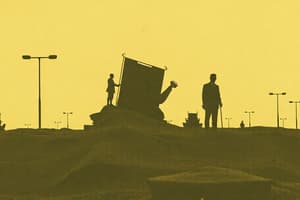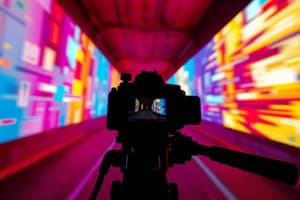Podcast
Questions and Answers
What effect does a high angle camera shot primarily have on the subject?
What effect does a high angle camera shot primarily have on the subject?
- It creates a sense of intimacy.
- It emphasizes the background context excessively.
- It makes the subject appear larger or more powerful.
- It can make the subject appear smaller or weaker. (correct)
Which camera angle is likely to create a sense of unease or disorientation?
Which camera angle is likely to create a sense of unease or disorientation?
- Low Angle
- Bird's Eye View
- Eye Level
- Dutch Angle (correct)
What type of shot would best convey deep emotional intimacy?
What type of shot would best convey deep emotional intimacy?
- Long Shot
- Extreme Close-Up (correct)
- Extreme Long Shot
- Medium Shot
Which composition technique involves placing points of interest at intersections of divided areas?
Which composition technique involves placing points of interest at intersections of divided areas?
In which scenario would you most likely use an Over-the-Shoulder shot?
In which scenario would you most likely use an Over-the-Shoulder shot?
What does the use of a Long Shot typically provide in a scene?
What does the use of a Long Shot typically provide in a scene?
Which of the following shots allows for including two subjects in the same frame?
Which of the following shots allows for including two subjects in the same frame?
What is the primary purpose of using Depth of Field in photography?
What is the primary purpose of using Depth of Field in photography?
Flashcards are hidden until you start studying
Study Notes
Camera Angles and Shots
Camera Angles
- Eye Level: Camera positioned at the subject's eye level; creates a neutral perspective.
- High Angle: Camera looks down on the subject; can make the subject appear smaller or weaker.
- Low Angle: Camera looks up at the subject; can create a sense of power or dominance.
- Bird's Eye View: Camera positioned directly above the scene; offers a unique perspective and can convey a sense of overview.
- Dutch Angle (Tilted Angle): Camera tilted to one side; creates a sense of unease or disorientation.
Camera Shots
- Extreme Close-Up: Focuses on a very small detail (e.g., an eye or an object); emphasizes importance.
- Close-Up: Frames a subject's face or a particular detail; conveys emotion and intimacy.
- Medium Shot: Shows the subject from the waist up; balances background context with subject focus.
- Long Shot (Wide Shot): Captures the subject within its environment; establishes context and setting.
- Extreme Long Shot: Shows a distant view of the subject; often used for establishing shots or landscapes.
- Two-Shot: Frames two subjects in the same shot; useful for dialogue and relationship dynamics.
- Over-the-Shoulder Shot: Shows a perspective from behind a character's shoulder; creates a sense of intimacy or focus on the conversation.
Composition Techniques
- Rule of Thirds: Divides the frame into thirds horizontally and vertically; places points of interest at intersections for a balanced composition.
- Leading Lines: Uses natural lines in the scene to guide the viewer's eye toward the subject.
- Framing: Uses elements in the scene to create a frame around the subject; adds depth and focus.
- Depth of Field: Controls the focus area in the shot; a shallow depth isolates the subject, while a deep depth includes more background detail.
Practical Considerations
- Choose camera angles and shots based on the story's emotional tone and context.
- Experiment with combinations of angles and shots to enhance visual storytelling.
- Be mindful of continuity when using different angles and shots to maintain a coherent narrative flow.
Camera Angles
- Eye Level: Neutral perspective; establishes an equal relationship between subject and audience.
- High Angle: Camera directed downwards; subjects appear diminished or vulnerable.
- Low Angle: Camera directed upwards; portrays subjects as powerful or authoritative.
- Bird's Eye View: Directly above the scene; provides a comprehensive overview of the action.
- Dutch Angle: Camera tilted; evokes feelings of tension or instability.
Camera Shots
- Extreme Close-Up: Highlights minute details; enhances the significance of select elements.
- Close-Up: Captures facial expressions or significant details; fosters emotional connection.
- Medium Shot: Displays subjects from the waist up; balances character focus with environmental context.
- Long Shot (Wide Shot): Includes subjects in their surroundings; establishes setting and context.
- Extreme Long Shot: Distant portrayal of subjects; commonly utilized for establishing shots or landscape visuals.
- Two-Shot: Features two subjects; effective for illustrating dialogue dynamics and relationships.
- Over-the-Shoulder Shot: Offers a viewpoint from behind a character; enhances the intimacy of conversations.
Composition Techniques
- Rule of Thirds: Divides the frame into thirds; guides placement of visual elements for aesthetic appeal.
- Leading Lines: Employs natural lines within the frame; directs viewer attention to focal points.
- Framing: Incorporates scene elements to encircle the subject; adds layers and enhances focus.
- Depth of Field: Manipulates the focus area; shallow depth highlights the subject, whereas deep depth retains background details.
Practical Considerations
- Select angles and shots to reflect the story's emotional undertone and thematic context.
- Experiment with various angles and shots to elevate visual storytelling impact.
- Maintain continuity when alternating angles and shots; ensures narrative coherence and flow.
Studying That Suits You
Use AI to generate personalized quizzes and flashcards to suit your learning preferences.




